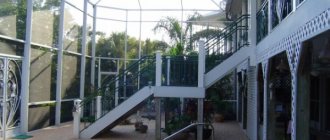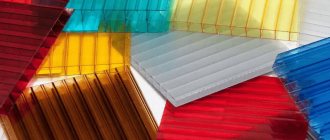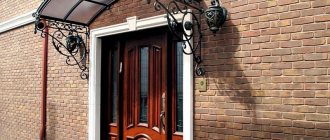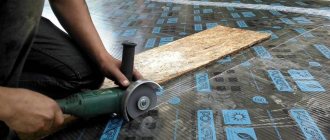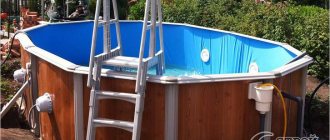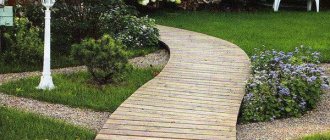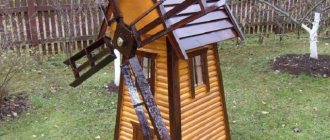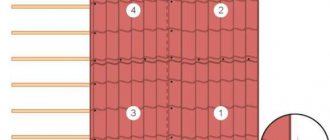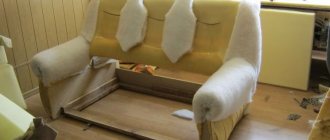Polycarbonate is a very durable plastic. The material is resistant to light, water, temperature changes - all these are its indisputable advantages.
The downside is that polycarbonate waste in nature can take several hundred years to decompose.
But how then to properly dispose of leftover polycarbonate and is it possible to do this at home? It turns out that the material can be sold for money or given a second life.
New life of material: DIY products
The easiest way to find a use for leftover material is in the garden .
Often, after installing gazebos, canopies or greenhouses, several small pieces of polycarbonate remain. These flexible sheets can be used to create original architectural forms in the garden.
Next, we’ll find out what crafts you can make from polycarbonate with your own hands for the garden and summer cottage.
Flowerbed for the garden
The simplest option for using polycarbonate waste is a round flower bed . Long sheets of material 25-30 cm wide are suitable for installation.
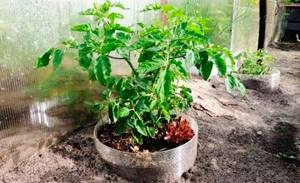
You can make a flowerbed in a few minutes by performing a few simple steps:
- dig a trench in the ground in the shape of the future flower bed with a depth of at least 10 cm;
- insert a sheet into the trench and carefully press the fence of the future flower bed into the ground;
- fill the fence with soil - the border should rise 5-10 cm above ground level.
The flowerbed is ready. If you have polycarbonate sheets of different lengths, you can create multi-level flower beds of bizarre shapes with your own hands.
If you have some old tires, read on for another way to create a flower bed.
beds
Small scraps of polycarbonate will also find use on the farm. use them to make fences for garden beds .
The principle of operation is similar to arranging a flower bed, but there is no need to bend or shape the sheets.
If the bed is large, it is recommended to install low wooden pegs around the perimeter .
From the remaining large-sized polycarbonate sheets, craftsmen also make small greenhouses for vegetables, canopies and other structures.
Crafts
You shouldn’t throw away even small scraps of cellular polycarbonate - they will turn into blanks for children’s crafts.
It's very easy to make a cute little thing:
- cut the plastic into squares and rectangles;
- Cover the edges of the resulting pieces with tape, or colored tape;
- Using a stencil, apply a design to the workpiece using a marker or stained glass paints.
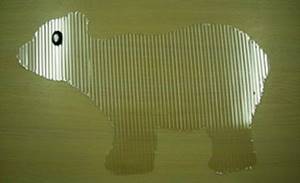
From leftover polycarbonate you can cut out animals, stars, hearts or any other interesting figures.
After cutting out such a figure, its edges must be polished with fine sandpaper so as not to damage your hands in the future.
All that remains is to add decorative elements and fastenings - and, for example, a Christmas tree toy with an exclusive design is ready.
Interior decoration with polycarbonate crafts
You can make a variety of items from plastic that will harmoniously complement your office or home interior. Polycarbonate decorative bottles and vases made in the Chinese style look luxurious Unlike glass, they will not break when dropped and will not fade in the sun.
Polycarbonate stained glass windows will decorate a cottage or country house. Artists create panels in the style of abstract art from colored plastic, from which it is impossible to take your eyes off. Needlewomen use scraps of sheets for bead paintings. From flexible multi-colored sheets you can create any models of transport, animal figurines, New Year's toys,
Nowadays plastic sheets are widely used for interior decoration. The flexibility of the material allows you to make many elements with your own hands.
For example, using a translucent sheet, you can make an interesting partition for zoning space, which will play both a functional and decorative role. Such a screen will provide privacy and, at the same time, preserve the integrity of the interior of the apartment.
Polycarbonate is a universal modern material from which you can make anything. The main thing is to show a little imagination.
Disposal at home
What to do if there is a lot of polycarbonate waste? It is unlikely that they will be burned or melted without the use of special equipment, because the melting point of polycarbonate is at least 300 degrees.
If you have knowledge of chemistry and access to some reagents, you can try to recycle polycarbonate at home using chemical methods .
The forums will help with this:
- chemport.ru;
- forum.e-plastic.ru.
If there is no inclination towards chemistry, the only solution is to collect the remaining polycarbonate and then hand it over to specialized recycling centers.
Installation of polycarbonate
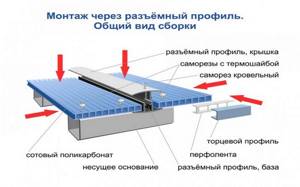
When performing various works from polycarbonate and creating different structures, one or another type of material is used. Moreover, each of them has its own installation nuances. For example, the monolithic variety is monolithic because it can neither be deformed nor divided and is mounted in solid sheets on frames or ready-made frames. The latter, by the way, can be:
- vertical,
- pitched,
- horizontal.
Installation of sheets is usually done in two ways - either dry or wet. The second option involves the use of polymer putty, which is applied to the frame or frame over the entire surface, and will subsequently hold the polycarbonate sheets.
Advice! Additional fastening can also be done at the corners of the sheets if the design requires it. Dry installation of polycarbonate is carried out exclusively through the use of nuts and bolts.
What is made from recycled polycarbonate?
Polycarbonate is highly recyclable without losing its physical and mechanical properties.
Optical quality suffers a little. After processing, yellowness appears, which intensifies with each subsequent processing cycle.
The amount of recyclables in production usually does not exceed 20%.
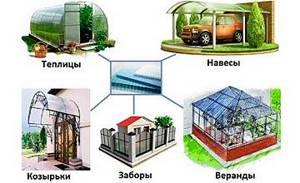
Many familiar things that we encounter every day are created from recycled material:
- canisters and containers for storing non-food products;
- containers for household chemicals;
- plastic car parts;
- parts of household appliances and office equipment;
- plumbing pipes;
- elements of street infrastructure.
The technology for thermomechanical processing of polycarbonate is similar to methods for processing other polymers. about plastic granulation by pyrolysis is also possible , which we discussed in detail here.
There are recycling companies in almost every city. Anyone can collect the remaining material, hand it over and receive a certain amount of money in return.
Before handing over polycarbonate waste to a collection point, you need to properly prepare . This will allow you to earn the maximum possible amount.
Correct installation of cellular polycarbonate with your own hands. Step-by-step instruction
Cutting technology
To beginners, the panels seem heavy and cumbersome, and cutting them seems like something out of the realm of high technology. But cutting can be done with a regular tool or a high-speed circular saw. In the latter case, use carbide discs with straight teeth. But if you don’t have such a tool, you can use an electric jigsaw. Some craftsmen make do with a simple sharp knife. For those who purchased polycarbonate with installation, everything will be done by a specialist. But you may want to change the color or thickness of the thermoplastic cover later. And cutting is not the most difficult, but important process.
- Secure the panel to eliminate the slightest vibration.
- Do not remove the protective film. The rules for installing polycarbonate say that the film prevents small chips and scratches when cutting.
- After completion of the work, it is necessary to remove all chips from the cavities.
How to position the panels correctly
An inexperienced but careful owner will cut out the necessary parts with maximum economy, arranging them at random. But such benefits can lead to bad consequences. A few rules will help you avoid them.
- The stiffening ribs are located vertically if the technology for installing cellular polycarbonate implies a vertical position of the sheet.
- When installing an arched structure, lay the ribs in an arc.
- If it is a sloping roof, then lay the stiffeners along its slope.
These conditions will ensure that condensation, rainwater and debris are removed from the cells. And although the edges of the panels are closed with a special profile, the tightness may be broken during operation.
Rules for drilling holes
After measuring and cutting, it was time to drill through the cellular polycarbonate. The features of installation with self-tapping screws need to be studied so as not to spoil the structure. The main thing is compliance with temperature gaps. The material is subject to expansion due to temperature differences. The larger it is, the more seriously you need to take this indicator. If you make a hole with the diameter of the fastening element, then sooner or later the entire surface will crack.
To make the correct calculation, determine the maximum temperature range and add the values. For example, the minimum figure in winter will be -30, and the maximum in summer +40. We have a value of 70. The coefficient of thermal expansion is 0.065 mm per degree. We multiply 70x0.065 = 4.55 mm - this is the size of the gap for each meter of the panel. If the sheet is painted, then add another 15°. The standard gap for a hole pitch of 35 cm will be 2-3 mm.
Now you will need drills of various diameters, self-tapping screws and thermal washers to attach the cellular polycarbonate. How to install fasteners correctly can be learned from the drawing. Use special plastic washers, seals and covers. In addition to the beautiful design, this will prevent additional heating of the panel from the metal.
Observe the drilling angle. Its minimum value is 90°, and its maximum is 118°. Try to mark the holes between the stiffeners 40 mm from the edges of the sheet. The video covers the installation of polycarbonate on a metal frame in an accessible language for beginners.
Having studied how to assemble polycarbonate using self-tapping screws, it becomes obvious that all these measures are aimed at extending the service life of the entire structure.
Attention! Never overtighten screws. The rigidity of the fastening, even taking into account thermal expansion, will give the effect of its absence.
Installation of polycarbonate video
How to prepare for delivery?
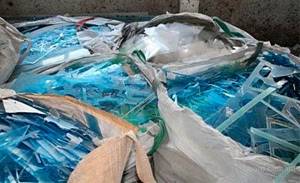
So, before handing over the remaining polycarbonate you need:
- Dry as much as possible .
- Clean from soil, concrete, polyurethane foam, food waste, and factory stickers.
- Inspect for organic contamination such as oils or grease.
- Remove all metal parts from the sheets - nails, staples, otherwise they will damage the crushing apparatus. Also, if possible, break large sheets yourself.
- Pack waste into bags.
Collection points do not purchase waste found in landfills from the population.
Monolithic polycarbonate
Monolithic polycarbonate is a universal, very durable polymer material used in many industries: from the furniture industry to military needs.
Strength
Suffice it to say that 12 mm thick monolithic polycarbonate can withstand a shot from a Makarov pistol from a distance of 6–7 meters. For comparison, the impact strength (Charpy) of plexiglass is 14-17 kJ/m2, and polystyrene - 5-6 kJ/m2. The impact strength of polycarbonate can be approximately estimated at 900-1000 kJ/m2.
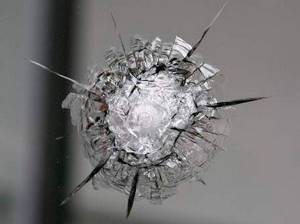
Crack in glass from a bullet
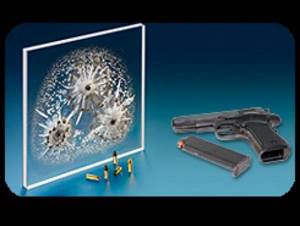
Cracks in glass from a pistol bullet. Bullet stuck in a polycarbonate sheet.
Profiled monolithic polycarbonate for roofing
At first glance, monolithic polycarbonate is very similar to plexiglass, but it is much better, since it is more flexible, easier to install, has UV protection, better transparency, and many colors.

Polycarbonate canopy over the terrace
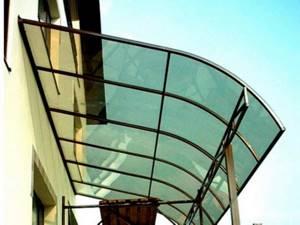
Polycarbonate visor

Multi-colored polycarbonate sheet with waves
Furniture industry
Monolithic polycarbonate is widely used in the furniture industry. In cabinet doors and cabinets, it is used instead of outdated glass and plexiglass, since the strength characteristics of monolithic polycarbonate are higher, and it provides more room for the designer’s imagination.

Polycarbonate reception desk
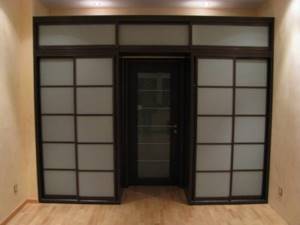
Wardrobe with sliding doors made of polycarbonate
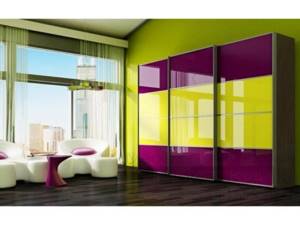
Wardrobe with sliding doors made of polycarbonate

Sliding wardrobe with polycarbonate doors

Armchairs made of transparent polycarbonate

Chairs made of transparent and colored polycarbonate
Medicine
In medicine, monolithic polycarbonate is used in the manufacture of prostheses. Since polycarbonate does not react to most chemicals, it is used for the production of various flasks and test tubes.
Chemicals hazardous to polycarbonate:
- Acetone;
- Methyl alcohol;
- Alkali;
- Ammonia.
Dentures and car parts are also made from monolithic polycarbonate.

Cylindrical flask made of transparent polycarbonate
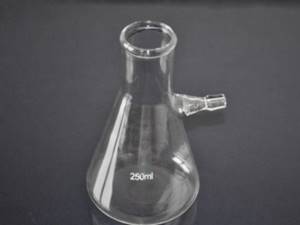
Clear polycarbonate flask

Prosthetic hand made of polycarbonate
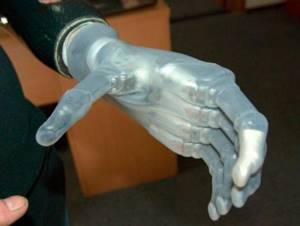
Prosthetic hand made of translucent polycarbonate

Polycarbonate denture
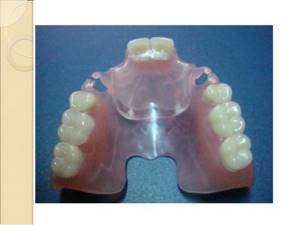
Dental removable denture made of polycarbonate
Military applications
The strength and transparency of monolithic polycarbonate has not gone unnoticed by the armed forces. As mentioned above, 10 mm thick monolithic polycarbonate can withstand a shot from a Makarov pistol from 6–7 meters.
It is used to make police shields and visors on police and military helmets, and in the production of armored glass.

Transparent polycarbonate police shield

Airplane headlight, covered with polycarbonate
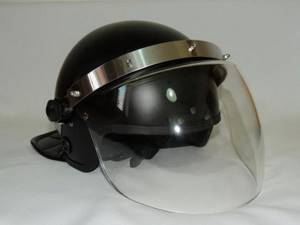
Safety helmet with polycarbonate visor Helmet with polycarbonate visor
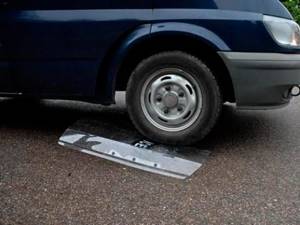
The car stands on a polycarbonate shield
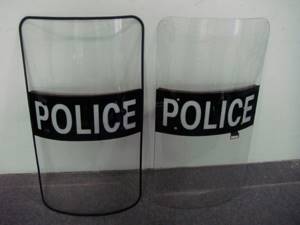
Polycarbonate police shields
Reception points
Many companies accept large volumes of polycarbonate for recycling, so they offer a waste pickup service .
The price for receiving such waste depends on several conditions :
- quality, purity of raw materials;
- color – white, transparent polycarbonate is more expensive;
- volume of waste (wholesalers are paid more);
- method of packaging the material (it will be more expensive to deliver it not in bulk, but in bags and containers).
Below is a list of enterprises in some Russian cities that collect and process polycarbonate waste, as well as the cost at which they can be delivered.
| City | Business name | Price per kg |
| Moscow | "Reception-polycarbonate.rf" | Depends on the type of waste. |
| Saint Petersburg | "Leaf" | From 10 to 48 rub. |
| Ekaterinburg | "Promsyrye" | Negotiable, at least 10 rubles. |
| Novosibirsk | "Astat Company" | From 10 to 85 rub. |
| Krasnodar | "KrasnodarVtorSnab" | From 14 to 44 rubles. |
Types of polycarbonate
Polycarbonate is a material consisting of a group of thermoplastics, polyesters of carbonic acid and dihydric alcohols of the general formula.

Due to its working properties, it is increasingly used as roofing elements. It has 2 types:
- cell phone;
- monolith.
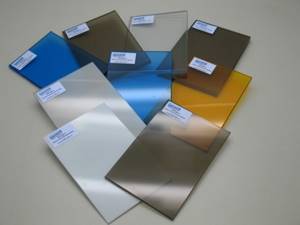
Note. It's the same quality. A cell phone consists of many cells, but a monolith does not have them. Cellular has less weight and has greater sound insulation.
Due to its unique performance characteristics, it is used as a roofing material in many structures.
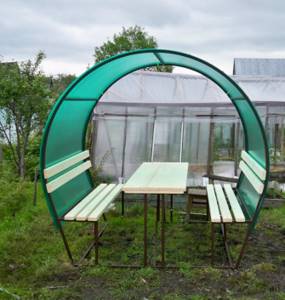
On the Internet there are many photos of polycarbonate products made by hand. Thanks to this unique opportunity, you can select the product you are interested in and use this example to make your own unique design.

Distinctive features of polycarbonate
Builders use 2 types of polycarbonate - structured (cellular) and monolithic. The latter is interesting due to its versatility - the roofs of small buildings are made from it, since it successfully replaces transparent glass and easily takes the desired shape. But the cost of such material is much more expensive than its structured counterpart. Cellular polycarbonate has gained a wide range of applications: it is used to make functional canopies, canopies and gazebos, and individual decorative figures for the garden. The main advantages of this material are low cost and light weight, durability and fire resistance, strength and good thermal insulation.
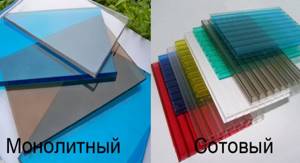
There are 2 types of polycarbonate used in construction: monolithic and cellular.
How to choose polycarbonate
To choose the right material, you need to consider a few key points.
What thickness of polycarbonate is needed?
For seasonal country greenhouses, the most economical options are suitable - 3.5; 3.8; 4 mm. Thin sheets of polycarbonate perfectly transmit light, withstand gusty winds and bend well, allowing you to build structures of various shapes and sizes.
The summer season is about to begin. If you have not yet acquired a durable and reliable greenhouse, we advise you to hurry up with your choice. Excellent options for every taste and budget can be found here. These greenhouses are made from high quality galvanized steel profiles and can withstand snow loads of up to 360 kg/sq.m.
Thick polycarbonate sheets (6, 8, 10 mm) are intended for more fundamental buildings, for example, fences, gazebos, garages, canopies over the porch, heated winter greenhouses, etc. But you should understand that the thicker the polycarbonate sheet, the more difficult it is to bend. Therefore, for arched structures, choose products up to 8 mm thick, and for vertical and inclined (pitched) structures, more durable cellular polycarbonate with a thickness of 8-10 mm is suitable.
What affects the color of polycarbonate
In addition to transparent, on the modern building materials market you can find polycarbonate of different colors and shades.
Polycarbonate in brown shades creates calm diffused lighting and transmits about 50% of the light. It is perfect for canopies, fences, and other enclosing structures that must simultaneously create shade, but at the same time let in sunlight.
Yellow polycarbonate also has a fairly high light transmittance for colored polycarbonate and is used in places where excess sunlight is needed - canopies, canopies, arched structures, transparent roofs, partitions, fences and fences. Under a canopy made of yellow polycarbonate, in cloudy weather you will feel like the sun is shining outside.
Polycarbonate in red shades transmits 40-55% of light. This material creates pleasant warm light shades. The scope of its application is quite wide: the construction of transparent roofs, canopies, arches, canopies, partitions, fencing, fences, stained glass windows, glazing of balconies, terraces and verandas, etc. Red polycarbonate is often used for arranging children's playgrounds, because... compositions with him turn out to be the brightest and most interesting.
Blue polycarbonate looks most harmonious when decorating sports fields and pool covers. This plastic also goes perfectly with facades in snow-white and beige colors and is suitable for a roof or fence in blue tones.
Green polycarbonate is an ideal option for any landscape design. This material combines well with the bright greenery of the surrounding nature and is a wonderful continuation of the summer landscape. Therefore, garden gazebos, canopies for swimming pools and cars, canopies over benches and swings are often made from it. The material of this color is also used for stained glass.
Using colored cellular polycarbonate, you can create a unique country interior or decorate the architecture of a building. There are many options for ideas with this material, and thanks to the flexibility of plastic, bringing them to life will not be difficult. The Polycarbo company offers its customers colored polycarbonate in yellow, orange, red, brown, bronze, green, blue and white. All presented materials have increased strength and a high degree of heat-insulating properties, are distinguished by reliable noise insulation, moisture resistance and resistance to deformation.
